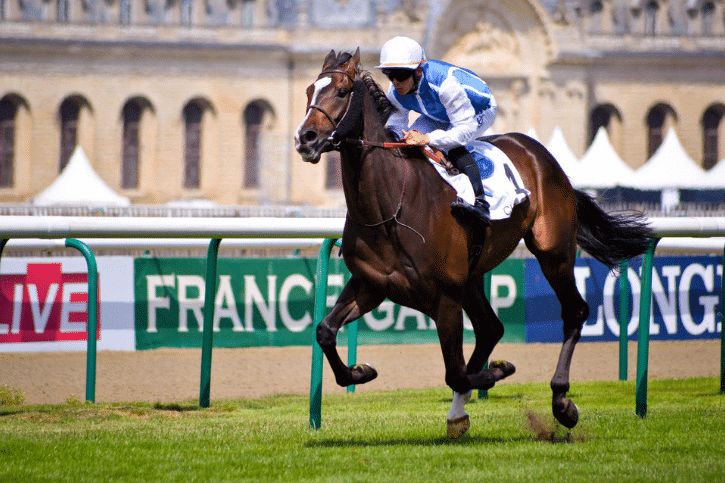What Is A Flat Race?
I bumped into one of my old friends in the food store yesterday and they mentioned that they were going to watch their favorite horse compete in a flat race.
I was curious as to what this was, so I decided to do some research about it.
So, what is a flat race?
Flat races are one of the most popular categories of horse races and they are run on the level field, usually on grass. These are high-speed races that are aimed at testing the horse’s stamina and speed, as well as the jockey’s skill. Since they are a speed race, flat races don’t include obstacles.
In this article we’ll take a look at some other questions you might be wondering about flat races.
For example, you may be wondering what horses can run in a flat race, what the difference between a flat race and jump race is, how long a flat race is and some of the various types of flat races.
Let’s not waste any time and get to answering these questions!
What are some types of flat races?
You might be wondering what some examples of specific flat race events are.
These can include Classics, Maidens and Handicaps.
This section will briefly discuss what these races are.
Firstly, Classics are a type of Flat race that take place as a set of 5 races.
They are restricted to horses that are aged 3 only.
Classics are run over 3 separate distances, ranging from 1 – 2 miles.
Only one horse has ever won four Classics in a row, and that was back in 1902!
Maiden races are another type of flat race, exclusively for horses who have never won a race before.
A horse is considered a maiden until they win a race.
Finally, the final type of flat race we’ll discuss are called Handicap races.
These are races where the horses carry different weights according to their speed and size in order to ‘handicap’ or disadvantage them.
The aim is for the horse to overcome the handicap and win the race.
What horses can run in a flat race?
Flat races can be considered as more of an umbrella term for a category of events that take place on the level field.
This means that the types of horses that can compete in flat races is entirely dependent on the event requirements itself.
For example, a maiden race involves horses who have never won a race before, who are typically aged between 4 and 7 years old.
Whereas a Classics event is exclusively for horses aged 3 years old.
However, most horses will be able to compete in at least one type of Flat race as there are several types with differing entry requirements.
What is the difference between a flat race and a jump race?
A common question that is asked surrounding the flat race discussion, is what exactly the difference is between a flat race and a jump race.
The answer to this question is actually quite simple.
A flat race takes place on a level field with no obstacles for the horses to overcome.
Whereas a jump race involves a series of obstacles (usually hurdles) placed throughout the race for the horse to jump over.
Jump races are used as a test of strength, control, and endurance for the horses as hurdles present a significant challenge in the competitive landscape.
In comparison, flat races are more concerned with the speed at which the horses can reach, therefore each separate event attempts to test different physical qualities.
What kind of ground are flat races run on?
We previously mentioned that most flat races take place on a grassy level field.
However, it should be noted that sometimes they can take place on fields that have AstroTurf.
There seems to be a growing trend towards flat races being run on synthetic surfaces as these materials usually have strong drainage systems which allows races to still go ahead in poor weather conditions (rain, frost, snow).
How long are flat races?
As mentioned, flat race is more of an umbrella term for a category of various racing events.
This means that the distance required of them can vary depending on the different type of race.
Generally speaking, a flat race is between 1 and 2 miles in length.
For example, a Classics flat event has races that are 1 mile, 1.5 miles and 2 miles.
These races are typically shorter in distance because of the immense speed, strength and stamina required of the horses competing in these events.
It can perhaps be suggested that if the distance was any further than 2 miles, it could potentially be dangerous to the horses’ health.
In conclusion, this article has answered the question, “what is a flat race?”.
Throughout the article, we explored the concept of the flat race in relation to horse-racing.
It was found that a flat race is the name of the wider category of races which take place on the level field.
More specific types of flat races were discussed, and these include the likes of Maiden races, Classics races and Handicap races.
Each type of flat race was found to carry its own rules and requirements, but the commonality between them is that they are all run on a flat, level field.
In discussing the difference between a flat race and a jump race, the difference is simply that a jump race makes use of hurdles as a way to test a horse’s agility and strength, whereas a flat race contains no obstacles and seeks only to challenge a horse’s speed.
Finally, we found that the distance of a flat race was entirely dependent on the nature of the event.
However, most flat races fall within the 1–2-mile range.
I hope this article has been helpful in answering any questions you have surrounding the topic of flat races!
